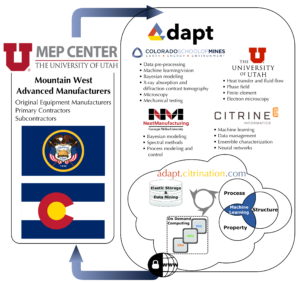The ADAPTSM Center’s work on behalf of the US Department of Defense Office of Economic Adjustment (DoD OEA) began in 2017 and has been extended into 2020. This collaborative effort with the University of Utah, Colorado School of Mines, and Carnegie Mellon University is focused on diversifying the manufacturing supply chain of the future.
A key part of the project, both in Colorado and Utah, is educating manufacturers – especially defense contractors – about metal AM. A strong foundation of metal AM knowledge and capability offers a path to economic resilience for manufacturers. AM provides flexibility to enable manufacturers to diversify and gives the DoD a way to build a more resilient defense supply chain based on AM.
“This collaboration sets the foundation of how we diversify the manufacturing supply chain of the future,” emphasized ADAPT Executive Director Aaron Stebner. “We’re moving away from the assembly line to a distributed network of AM machines. That promotes a more even keel for the defense manufacturing supply chain and provides opportunities for others to get involved.”
One example of the potential AM holds is the redesign of the MRAP hinge assembly for the Army’s TARDEC group featured in last month’s ADAPT newsletter.
Through workshops and training sessions, ADAPT and the collaborating institutions on the DoD OEA program have been able to help local manufacturers. “We invite them to learn about the technical and business case for using metal AM to enhance and diversify their businesses,” said Bart Raeymaekers, project lead with University of Utah. “That helps make their companies and the workforce as a whole more resilient and able to deal with the ups and downs in defense spending.”
In Utah, work with Hill Air Force Base has focused on new approaches to keep the aging A-10 Warthog and the brand-new F-35 Lightning II fleets in the air. “The supplier that made a part may no longer exist, or we may have better ways to build a part today than when the plane was originally manufactured. Using AM is proving effective in sustainment for old aircraft and in field repairs for very new aircraft,” said Raeymaekers.
Together, the team is printing parts with titanium and Inconel using different process parameters to characterize material and mechanical properties, which are stored in a cloud-based database. Machine learning algorithms from Citrine Informatics then mine the database produced.
The result is data-driven models that can direct future research. “It takes a lot of trial and error to tune process parameters for a metal AM process to produce parts with the desired properties,” said Raeymaekers. “We’re working to use machine learning to accelerate that work. Usually, we work to understand the physics and then capture that in a mathematical model. With machine learning, we build models based on large data sets.”
Another key focus of this collaborative approach is exploring how machine learning and data analytics can enhance communication across the supply chain. The data-driven approach allows technicians to share information with R&D engineers, and engineers to share their discoveries with technicians, without the significant communication gaps that often muddy that part of the process.
Phase 1 of the DoD OEA program has proven successful enough that Phase 2 funds were awarded based on the progress achieved in Phase 1. That extends the work of ADAPT, Citrine, Colorado School of Mines, University of Utah, and Carnegie Mellon University, along with the University of Utah MEP Center, to July 2020. The results achieved through the TARDEC project, initiated by Fort Carson in Colorado, created an opportunity to discuss ways to apply AM to help Peterson Air Force Base with some specific needs as the project moves into Phase 2.
The efforts in the DoD OEA program have ranged from granular research – Carnegie Mellon’s work to understand the fundamentals of porosity in AM builds, why it happens, where it comes from, and how to control for and avoid it – to strategic questions of the nation’s defense supply chain and diversifying and increasing resiliency of supply chains for all of manufacturing. This important work continues to demonstrate the potential of AM.
